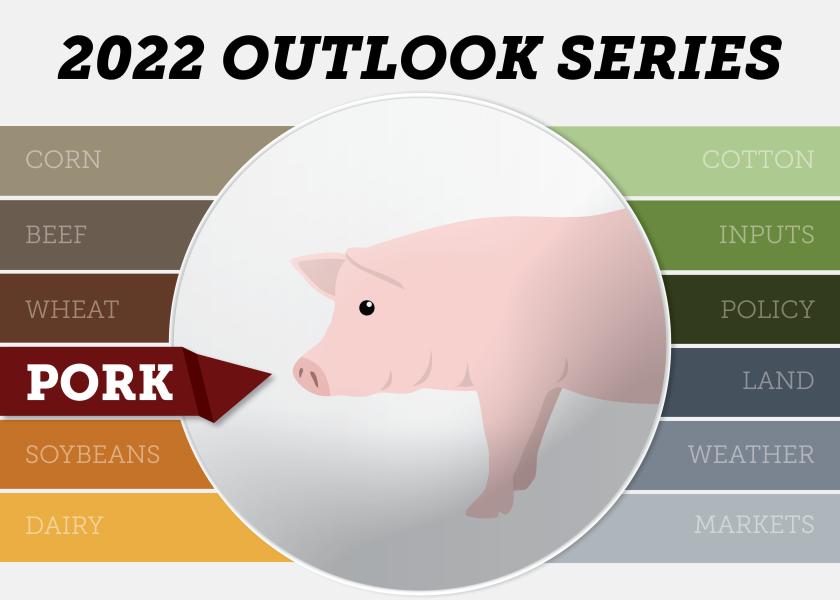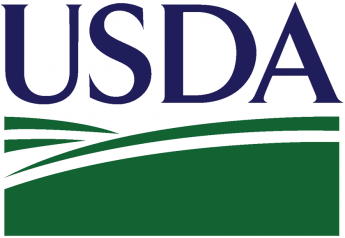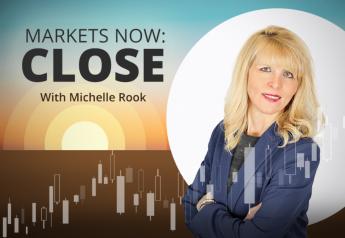2022 Outlook: Pork Industry Rises from the Rubble

The pork industry is still evolving out of the rubble of the coronavirus pandemic, says Lee Schulz, an economist at Iowa State University. But certainly, more optimism abounds in the U.S. pork outlook heading into 2022 than the industry experienced a year ago.
“With the world in the throes of the COVID-19 pandemic, no one knew how things were going to fall out a year ago,” says Joe Kerns, president of Partners for Production Agriculture. “Who could blame us?”
Although the U.S. is still feeling the impact of COVID-19, it is not surprising us any longer, Kerns adds.
“We are trying to understand the ramifications rather than having all kinds of questions in the air, specifically as it relates to the animal supply relative to shackle space,” Kerns says.
Economists believe pig farmers have every reason to be more confident going into 2022 so long as the U.S. can keep foreign animal diseases such as African swine fever (ASF) out of the country.
“Biosecurity is likely to be top of mind in 2022 — not only to keep African swine fever from entering the U.S., but also to address many of the herd health challenges we saw in the past year,” says Christine McCracken, executive director animal protein at Rabobank.
U.S. hog prices depend on domestic meat demand as well as the ability of the industry to export pork out of the country, adds Scott Brown, an economist at the University of Missouri. Strong exports of U.S. pork to China will move hog prices higher, while a reduction could make prices move lower.
Structural drivers such as labor shortages and inflation will continue to keep the 2022 pork outlook interesting.
“Despite rising pay, finding employees is more and more difficult. It’s a labor shortage, and I don’t use the word shortage lightly. The robust demand for agricultural labor faces a backdrop of increasingly threatening macroeconomic and demographic trends,” Schulz says.
These four economists weigh in on the 2022 pork outlook and share their advice for pig farmers heading into the new year.
What is your 2022 pork outlook?
Brown: Hog prices in the first half of 2022 should be reasonably good as pork supplies remain below year-ago levels. Prices probably won't reach 2021 levels but should keep producers in the profitable range. The second half of 2022 is less certain as supplies expand, placing downward pressure on prices. For the year, hog prices should be around 10% lower than 2021.
Kerns: My outlook is cautiously favorable. I think we’ve got a good setup. There are things we need to do – specifically, biosecurity to keep ASF at bay -- but I think we have a very promising outlook. On a scale of 1 to 10, I give the pork outlook an 8. Input costs moved higher in 2021 and should moderate a bit in 2022. The real key is, and always be, what happens to revenue. The forward curve for pork looks good, but the trick is turning the demand for pork into demand for pigs to allow the producer to participate.
McCracken: We expect another strong year as the supply of pork is expected to be fairly well balanced with demand – which typically supports a healthy margin environment for producers and packers. That isn’t to say the industry will not face challenges. The same cost pressures we saw this year, including labor, energy and distribution, are still going to be issues in 2022 and in some cases, possibly worse. Regulatory constraints will also raise costs in the year ahead – not only in California with Proposition 12, but with line speeds, immigration and water use. Overall inflation in 2022 will make the business more challenging for producers and consumers, which could ultimately impact demand for pork. The upside of rising costs and labor constraints is a general reluctance by producers to rapidly expand production, which should extend this period of profitability for the industry.
Schulz: Swine inventory expansion or contraction seem equally likely given current and potential market signals. Costs were a headwind to producer returns in 2021. According to the Iowa State University model for farrow-to-finish production, costs were estimated to have increased 26% or $17 per carcass hundredweight (cwt) in 2021 compared with 2020. This translates into an increase of $35 per head in 2021 compared with 2020. Feed costs were a big part of this, but pork producers use numerous inputs and services and most all were up notably in 2021. Many non-feed variable costs could be up again in 2022. Propane prices, for instances, are expected to jump this winter. Higher hog prices have helped offset the rise in costs. On an annual basis, hog prices were 50% higher in 2021 than in 2020. Moderation in costs and revenues seems imminent for 2022. Costs are forecasted to decrease 5% from 2021 levels. Still, on an annual basis, costs are expected to remain quite elevated relative to historical levels. Hog prices are forecasted to decrease 13% from 2021 levels.
What will be the drivers of change for pork producers in the year ahead?
Brown: Pig inventory levels and productivity growth will be supply-side drivers in the year ahead. The last Hogs and Pigs Report was bullish regarding current hog inventories. Increases in sows farrowed or additional sow inventory could stress processing capacity in late 2022. U.S. consumer meat demand and the level of pork imports by China will be the big demand drivers in 2022.
Kerns: We've barely begun to understand the ramifications of the shift to renewable diesel fuel. Soybean oil is a highly coveted lipid that will more than likely move into further refinement with the renewable diesel concept. As a feeding industry, we are not going to have as much fat at our availability and what we will have will be more expensive. The flipside? We're going to have an abundance of soybean meal available that should be competitively priced. On the revenue side, we're tracking favorably. We're compromised now with the labor situation in plants preventing us from conversion. Producers will receive a bit lower value for the product than they normally would if we had a full labor force. Unfortunately, I don't see that changing. With the exception of a border closing disease, we've got every reason to be optimistic about how we look from the revenue side and even the input side.
McCracken: There are a few structural drivers impacting the industry and it is difficult to tease out which are cyclical and which are likely to have a lasting impact. Herd health challenges and the threat of ASF are likely to drive accelerated investment in infrastructure and changes in management. But to be successful, we still need labor – and that is a constraint with no easy fix. Labor will remain the limiting factor in 2022. Competition for workers is fierce and that will not only force the industry to pay more to attract and retain talent, but it will also change how the industry views labor going forward. A shortage of drivers, workers at our plants or servers at our restaurants will not only add cost, but it will ultimately impact the global competitiveness of U.S. pork.
Schulz: I would be remiss if I didn’t mention all the possible usual suspects, including domestic and export demand; any changes in the global epidemiological conditions of ASF; the economy, state and national policy debates; productivity/disease impacts; and weather/grain markets. Some of these are obviously interrelated. The challenging labor situation certainly needs to be on this list. One thing clearly revealed by the COVID-19 pandemic is heightened vulnerability where labor is most involved.
If you could offer up one piece of advice to producers in 2022, what would it be?
Brown: Risk management will be more important than ever, and producers should prepare for continued market uncertainty. Both hog prices and input prices will be prone to volatility. Feed costs have been moderating for several weeks but future price moves will hinge on the size of the South American crop and U.S. corn and soybean plantings next spring. Fertilizer prices are making that planting decision more difficult here in the U.S. Next year, U.S. hog prices will hinge on domestic meat demand strength as well as the ability to export pork out of the country. China will play a key role again in 2022. Strong exports of U.S. pork to China will move hog prices higher, while a reduction could make prices move lower.
Kerns: The pork production community has a relatively recently revised tool from the government available in the form of subsidized insurance. I think every single producer owes it to themselves to participate in these markets, to take advantage of a tool they might not know about but is absolutely becoming our go-to methodology to protect revenue into the future. The LRP, which stands for livestock risk protection, or LGM, which stands for livestock gross margin, are two different programs that went through very significant changes in 2020. They did so without much fanfare because we were in the throes of COVID-19 in an unprofitable scenario. As we work through 2021, and look forward, both of these programs continue to become more robust. The current administration wishes to enhance them. I think they are fantastic tools to protect what is already on a forward curve. If we do get some aberration, it provides pork producers an economical way to protect and create a viable future.
McCracken: Be prepared for disruption. There is a growing list of factors that could derail the industry, but with planning and risk management you can limit the severity of their impact on your operations. The U.S. reliance on global markets for 27% of demand remains a huge vulnerability. The loss of any one market can be managed, but more widespread disruption remains a risk. Part of the answer lies in the diversification of exports, but there also needs to be a relentless focus on biosecurity. Explore every tool to limit your exposure or consider diversifying your risk.
Schulz: Margins are expected to tighten in 2022. Be prepared to make the best of the situation by maximizing pricing opportunities and minimizing losses. Consider all tools and strategies available to accomplish price risk management goals. For decades, it seemed price risk management meant taking a position(s) in the customary futures or options markets. These are still available and can be very effective. There are also several enhanced or new tools available, including Livestock Risk Protection (LRP), Livestock Gross Margin (LGM) and CME Pork Cutout futures and options contracts.
More from Farm Journal's PORK:







